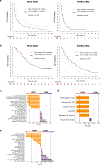Expression of T-Cell Exhaustion Molecules and Human Endogenous Retroviruses as Predictive Biomarkers for Response to Nivolumab in Metastatic Clear Cell Renal Cell Carcinoma
- PMID: 33219016
- PMCID: PMC8443005
- DOI: 10.1158/1078-0432.CCR-20-3084
Expression of T-Cell Exhaustion Molecules and Human Endogenous Retroviruses as Predictive Biomarkers for Response to Nivolumab in Metastatic Clear Cell Renal Cell Carcinoma
Abstract
Purpose: We sought to validate levels of CD8+ tumor-infiltrating cells (TIC) expressing PD-1 but not TIM-3 and LAG-3 (IF biomarker; Pignon and colleagues, 2019) and to investigate human endogenous retroviruses (hERV) as predictors of response to anti-PD-1 in a randomized trial of nivolumab (nivo) versus everolimus (evero) in patients with metastatic clear cell renal cell carcinoma (mccRCC; CheckMate-025).
Experimental design: Tumor tissues (nivo: n = 116, evero: n = 107) were analyzed by multiparametric immunofluorescence (IF) and qRT-PCR. Genomic/transcriptomic analyses were performed in a subset of samples. Clinical endpoints included objective response rate (ORR), progression-free survival (PFS), overall survival (OS), and durable response rate (DRR, defined as complete response or partial response with a PFS ≥ 12 months).
Results: In the nivo (but not evero) arm, patients with high-IF biomarker density (24/116, 20.7%) had higher ORR (45.8% vs. 19.6%, P = 0.01) and DRR (33.3% vs. 14.1%, P = 0.03) and longer median PFS (9.6 vs. 3.7 months, P = 0.03) than patients with low-IF biomarker. By RNA sequencing, several inflammatory pathways (q < 0.1) and immune-related gene signature scores (q < 0.05) were enriched in the high-IF biomarker group. When combined with the IF biomarker, tumor cell (TC) PD-L1 expression (≥1%) further separated clinical outcomes in the nivo arm. ERVE-4 expression was associated with increased DRR and longer PFS in nivo-treated patients.
Conclusions: High levels of CD8+ TIC expressing PD-1 but not TIM-3 and LAG-3 and ERVE-4 expression predicted response to nivo (but not to evero) in patients with mccRCC. Combination of the IF biomarker with TC PD-L1 improved its predictive value, confirming our previous findings.
©2020 American Association for Cancer Research.
Figures



References
Publication types
MeSH terms
Substances
Supplementary concepts
Grants and funding
LinkOut - more resources
Full Text Sources
Medical
Research Materials
Miscellaneous

